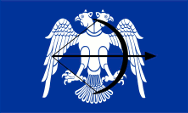mobile View, to the German Version tap the flag


- historical empire
- ca. 1040–1150
• Flag
• Meaning/Origin of the Flag
• Numbers and Facts

alleged flag of the Seljuk Empire,
Thanks to: Faruk Tezer,
Source, by:
anamurunsesi.com,
Alimohammadi23,
CC BY-SA 4.0, via Wikimedia Commons




As depicted here, one imagines today what the flag of the Seljuk Empire would have looked like: an eagle with two heads with a taut bow in front of it on blue or even light blue cloth. The double-headed eagle has indeed survived, but it was probably only the symbol of the Seljuk dynasty. The eagle was probably first used by Kayqubad, but certainly goes back to his father Kaykhusraw who was half Byzantine, which makes the transition of the symbol of the double-headed eagle from Byzantium to the Seljuks easy to trace. However, the eagle was not even depicted on coins, so it played no role in reality. Everything else about this flag is pure speculation, starting with the bow: The Seljuk archers were famous and notorious for their agility and marksmanship, and they laid the foundation for the empire's power, but there is no known depiction of the bow on flags. This continues with the colour blue, which is considered the colour of the Turkish and Mongolian peoples and thus appears today in some flags, such as Mongolia or Kazakhstan. It becomes even more extreme with light blue, a colour in which every proud Turk must recognise the colour of the coats of the guards of Turkish President Erdogan. In reality, there are no flags handed down for the Seljuks as we know them today. There were banners, but they were plain black and sometimes covered with symbols.
Source: Volker Preuß, Wikipedia (EN)

The Seljuks have not been a nation but a dynasty. It has its roots in Seljuq. He was the chieftain of the Turkish tribe of the Oghuses. He came with his tribe from the region of Dshend (in the today’s Kazakhstan eastern the Aral Lake) about the year 1000, conquered the town of Bukhara (in the today’s Uzbekistan) and converted to Islam. Already after few years he and his successors ruled over a large area around the town. In the year 1037 the Seljuks left Bukhara and went to Khorasan (a landscape in the northeast of the today’s Iran), which they conquered completely. Under Togril-Beg was conquered the whole Iran in the year 1040, Mesopotamia (Iraq and Syria) between 1045 and 1048, and in 1055 Bagdad. Alp Arslan – the successor of Togril-Beg – conquered between 1070 and 1071 Yerusalem and parts of the Byzantinian Empire (Anatolia). The conquest of Yerusalem was especially fatal, because of that became banished the hitherto there ruling islamic Fatimids and the holy places in Yerusalem became closed for Christians. The answer for that politics were the christian crusades, which were done for a free access to the holy places. About 1150 the Empire of the Seljuks crumbled into several states, in the today’s Syria to 1174, in the northwest of the today’s Iran to 1194. In Anatolia the Rum-Seljuks became dependent from the Mongols in 1243 and they ruled there until 1308.
Source: Wikipedia (EN)


![]()




